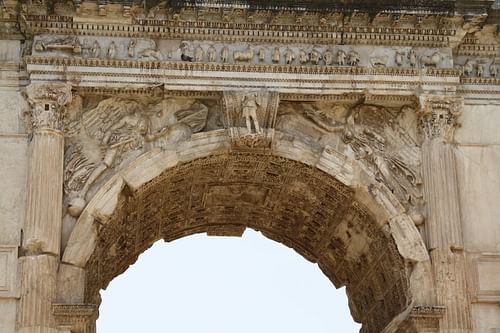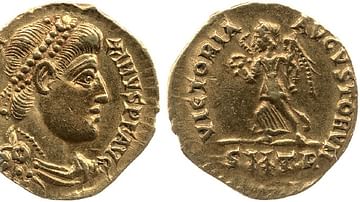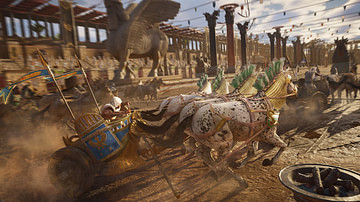The Arch of Titus is a Roman Triumphal Arch which was erected by Domitian in c. 81 CE at the foot of the Palatine hill on the Via Sacra in the Forum Romanum, Rome. It commemorates the victories of his father Vespasian and brother Titus in the Jewish War in Judaea (70-71 CE) when the great city of Jerusalem was sacked and the vast riches of its temple plundered. The arch is also a political and religious statement expressing the divinity of the late emperor Titus.
Inscription
The arch was constructed using Pentelic marble, with the attic part in Luna marble. The original inscription on the east side of the arch is still in situ, although originally the letters would have been inlaid with gilded bronze. It reads:
SENATUS
POPOLUS QUE ROMANUS
DIVO TITO DIVI VESPASIANI F
VISPASIANO AUGUSTO
(The Senate and People of Rome, to Divus Titus, son of Divus Vespasian, Vespasian Augustus). The use of 'Divo' for Titus indicates that the arch was erected after the death of the emperor in 81 CE. The inscription on the west side describes the refurbishment of the monument by Pope Pius VII in 1821 CE.

Decorative Sculpture
With only a single opening the arch is smaller and more modest in its decoration than other surviving arches such as those of Constantine and Septimius Severus. Also, the decorative sculpture has not survived the ravages of time very well. Nevertheless, one can still see the significance of some of the sculpture scenes, notably, the side panels. These marble reliefs are set either side of the inner arch and measure 2.04 m high by 3.85 m long. One panel shows the start of Titus' 71 CE victory triumph procession as it passes through the Porta Triumphalis to the Forum Boarium with the participants carrying booty from the Temple of Jerusalem after the sacking of the city. The booty includes a seven-branched candelabra (menorah), silver trumpets, and perhaps even the Ark of the Covenant. Some figures carry placards which would have probably indicated the names of the conquered cities and peoples.
The other relief panel is carved in three-quarter view and has Titus riding a four-horse chariot (quadriga) and shows him being crowned by a personification of Victory. The goddess Roma stands in front, holding the bridle of one of the horses. The two figures to the right of the chariot are personifications of the people of Rome (naked torso) and the Senate (wearing a toga).
The two relief panels are significant in the history and development of Roman art, as they are the first full attempt by Roman sculptors to create the illusion of space. This is successfully achieved in several ways; the figures are portrayed in three-quarter view, the background figures are so rendered that they recede gradually into the distance, the central figures are carved in higher relief than those on the edges, and the whole panel is curved slightly inwards.
Running around the whole arch is a small frieze which depicts the whole triumphal procession, and above the intrados winged victories each stand on a globe and hold banners, trophies, laurel wreaths, and palm fronds. Set in the centre of each side of the archway is a keystone representing Roma and the Genius of the Roman People. The interior vault is coffered with a central representation of the deified Titus (apotheosis) being carried to the heavens by an eagle. Originally, the whole arch was finished off in customary style with a huge bronze quadriga which would have stood on top of the arch.
Later History
The arch was incorporated into fortifications built by the Frangipani family in medieval times and suffered as a consequence. The significant restoration of the monument was carried out in the 19th century CE, in particular, on parts of the piers and attic using Travertine limestone. In fact, the whole arch was dismantled and reassembled piece by piece. In the present day the foundation blocks of the arch are visible, as the original roadway would have been higher.










